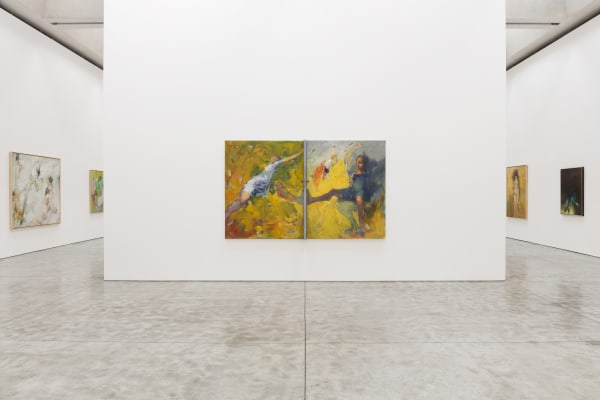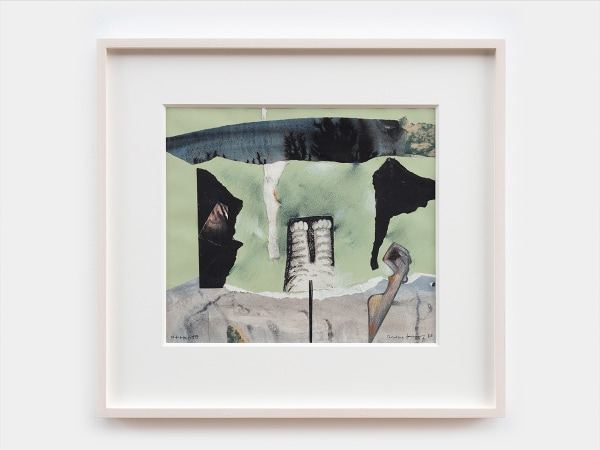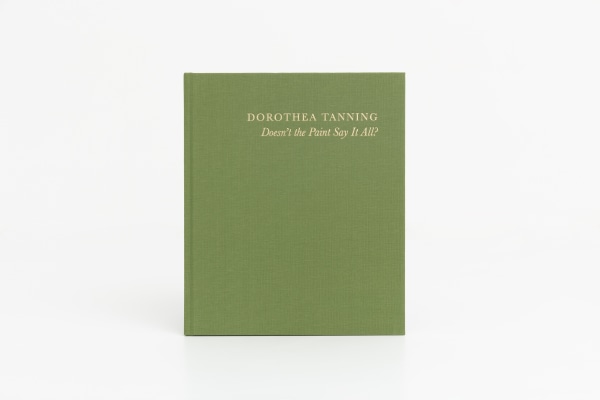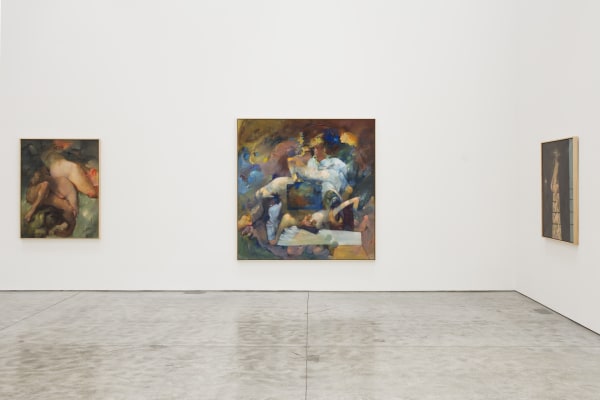Dorothea Tanning
-
-
BiographyBorn in Galesburg, Illinois, 1910
Died in New York, New York, 2012 -
"Around 1955, my canvases literally splintered. Their colors came out of the closet, you might say, to open the rectangles to a different light. They were prismatic, surfaces where I veiled, suggested and floated my persistent icons and preoccupations, in another of the thousand ways of saying the same things."
–Dorothea Tanning, from Between Lives: An Artist and Her World. New York: W.W. Norton & Company, 2001, p. 178. -

Photograph by Robert Bruce Inverarity, 1948.
Robert Bruce Inverarity Papers, ca. 1840-1997, Archives of American Art, Smithsonian Institution, Washington, D.C. -
Tanning’s paintings from the 1940s—several of which have become icons of the period—render figures in disquieting dreamscape settings, often in varying stages of transformation. The self-portrait Birthday (1942, Philadelphia Museum of Art) depicts the artist with a fantastical winged creature opening the first in a series of doors symbolizing those endless possibilities of what might lie ahead, while Eine Kleine Nachtmusik (1943, Tate) represents a pair of young girls in a supernatural hotel-like environment. In the years that followed, many spent in Sedona, Arizona, Tanning’s images become increasingly enigmatic and ambiguous, often including the likeness of her beloved Lhasa apso, Katchina, as an outsized character in their suggested narratives.
By the late 1950s, Tanning had moved to Paris. During this period, her representational style yielded to greater abstraction, and ethereal bodies began to shift and merge in an “ever-intensifying complexity of planes.” A painting emblematic of this period, Insomnias (1957, Moderna Museet), appears as a fractured stained glass window washed in hues of blue, violet, and rust. “I wanted to lead the eye into spaces that hid, revealed, transformed all at once,” said Tanning of the work, “where there would be some never-before-seen image, as if it had appeared with no help from me.” Throughout the 1960s, Tanning explored the plays of color, light, shape, and volume in increasingly opaque atmospheres, bringing her compositions to the brink of abstraction, but never abandoning the figure completely. In 1969, artist began fashioning corporeal forms from fabric stuffed with wool that appear to both emerge from and melt into their settings. These pioneering soft sculptures culminated in an immersive installation, Hôtel du Pavot, Chambre 202 (1970–73, Centre Georges Pompidou). She rediscovered the expressive potential of more discernable figures and settings in her paintings of the 1970s, still holding to the Surrealist philosophy that, as she described, “there are realities that have nothing to do with logic; and that diving into the subconscious—I call it surconscious—is the way to find them.”
Relocating once again to New York City following Ernst’s death in 1976, Tanning maintained an active studio practice through the 1980s and ‘90s, creating some of her most ambitious paintings, collages, and works on paper. In the later years of her life, Tanning dedicated more of her time to writing, publishing two memoirs (1986, 2001), a novel (2004), and two collections of poems (2004, 2011), the last of which was released just months before she died in 2012 at the age of 101.
Although Tanning celebrated the female form, Tanning believed that gender-based analyses of her work did more to confine it than to illuminate it. She emphatically rejected the categorization of woman artist, stating: “You may be a woman and you may be an artist; but the one is a given and the other is you.”
In her lifetime, Tanning was the subject of major exhibitions at the Philadelphia Museum of Art, Pennsylvania (2000); the Camden Arts Centre, London (1993); Malmö Konsthall, Sweden (1993); and the Centre Pompidou, Paris (1974). In 2018, she was the subject of a major retrospective at the Museo Nacional Centro de Arte Reina Sofía in Madrid, which traveled to Tate Modern in London until 2019. In 2022, Tanning’s work was included in The Witches Cradle, one of five historical sections embedded within the 59th Venice Biennale. Earlier that year, Kasmin organized the most comprehensive exhibition of Tanning’s work for a U.S. audience in decades, Doesn’t the Paint Say It All?, in collaboration with the Destina Foundation and the Dorothea Tanning Foundation. The exhibition was accompanied by a fully illustrated catalogue that featured three newly commissioned essays by noted scholars of Surrealism and a 1995 essay by Tanning entitled “To Paint,” named one of the best art books of 2022 by Hyperallergic. The most recent definitive monograph on the artist, authored by Victoria Carruthers, was published by Lund Humphries in 2020.Tanning’s work is held in numerous prominent U.S. and international institutions, including the Art Institute of Chicago, Illinois; the Los Angeles County Museum of Art, California; the Menil Collection, Houston; the Metropolitan Museum of Art, New York; Moderna Museet, Stockholm; the Musée d’Art Moderne de la Ville de Paris, France; the Musée National d’Art Moderne, Centre Georges Pompidou, Paris; the Museo Centro Nacional Reina Sofía, Madrid; the Museum of Fine Arts, Houston; the Museum of Modern Art, New York; the National Gallery of Art, Washington, D.C.; the National Gallery of Australia, Canberra; the Philadelphia Museum of Art, Pennsylvania; the San Francisco Museum of Modern Art, California; the Smithsonian American Art Museum, Washington, D.C.; Tate Modern, London; the Wadsworth Atheneum Museum of Art, Hartford; the Walker Art Center, Minneapolis; and the Whitney Museum of American Art, New York, among others.
-
Works

Dorothea Tanning
Inutile (Useless), 1969oil on canvas35 x 45 5/8 inches
88.9 x 115.9 cmCopyright The Artist -
Exhibitions
-

Encyclopedia:
September 4 – October 24, 2024 297 Tenth Avenue, New York
The Late Collages
of Dorothea TanningThe second solo exhibition of work by Dorothea Tanning (1910-2012) at Kasmin concentrates on her late-career collages from the 1980s and 1990s. Celebrating the multidisciplinary spirit of her work, Encyclopedia: The Late Collages of Dorothea Tanning delves into the artist’s universe where literary devices, from humor and irony to paradox and repetition, combine with her personal visual lexicon to inspire, as she once wrote, “Art as metaphor for language.”View More -

Dorothea Tanning: Doesn't the Paint Say It All?
March 3 – April 16, 2022 509 West 27th Street, New YorkDorothea Tanning: Doesn’t the Paint Say It All? brings together canvases and works on paper drawn from the artist’s remarkable oeuvre to present the most comprehensive solo presentation of her work for US audiences in decades. This is the first exhibition at Kasmin dedicated to the work of Tanning, whose pioneering explorations into the space between abstraction and figuration continue to influence vital painters today.View More
-
-
News
-

Encyclopedia: The Late Collages of Dorothea Tanning featured in Hyperallergic
by Natalie Weis September 25, 2024Encyclopedia: The Late Collages of Dorothea Tanning brings together 19 collaged works, most of which date from the late 1980s. Tanning had already published the first of her two memoirs and was increasingly turning to literary pursuits. The collages, with their scraps of fabric, tissue, paper, watercolor, and ink, can give the sense that the artist picked up past works’ detritus from her studio floor and decided she might as well make art out of it. Largely abstract, with a few figurative elements (the artist’s hands, cats’ paws, a faucet, a bicycle), the pieces serve to ignite viewers’ imaginations and encourage them to fashion their own interpretations.View More -

New Publication
Dorothea Tanning: Doesn't the Paint Say it All? August 15, 2022 View More -

Dorothea Tanning reviewed in Forbes
by Natasha Gural March 11, 2022 View More -

Dorothea Tanning reviewed in The Art Newspaper
by Daniel Cassady March 8, 2022 View More
-
-
contact_form
Send me more information on Dorothea Tanning
-
Explore
- Diana Al-Hadid
- Alma Allen
- Theodora Allen
- Sara Anstis
- Ali Banisadr
- Tina Barney
- Judith Bernstein
- JB Blunk
- Mattia Bonetti
- William N. Copley
- Cynthia Daignault
- Ian Davenport
- Max Ernst
- Liam Everett
- Leonor Fini
- Barry Flanagan
- Walton Ford
- Jane Freilicher
- vanessa german
- Daniel Gordon
- Alexander Harrison
- Elliott Hundley
- Robert Indiana
- Lee Krasner
- Les Lalanne
- Matvey Levenstein
- Lyn Liu
- Robert Motherwell
- Jamie Nares
- Nengi Omuku
- Robert Polidori
- Jackson Pollock
- Elliott Puckette
- Alexis Ralaivao
- George Rickey
- James Rosenquist
- Mark Ryden
- Jan-Ole Schiemann
- Joel Shapiro
- Bosco Sodi
- Dorothea Tanning
- Naama Tsabar
- Bernar Venet








